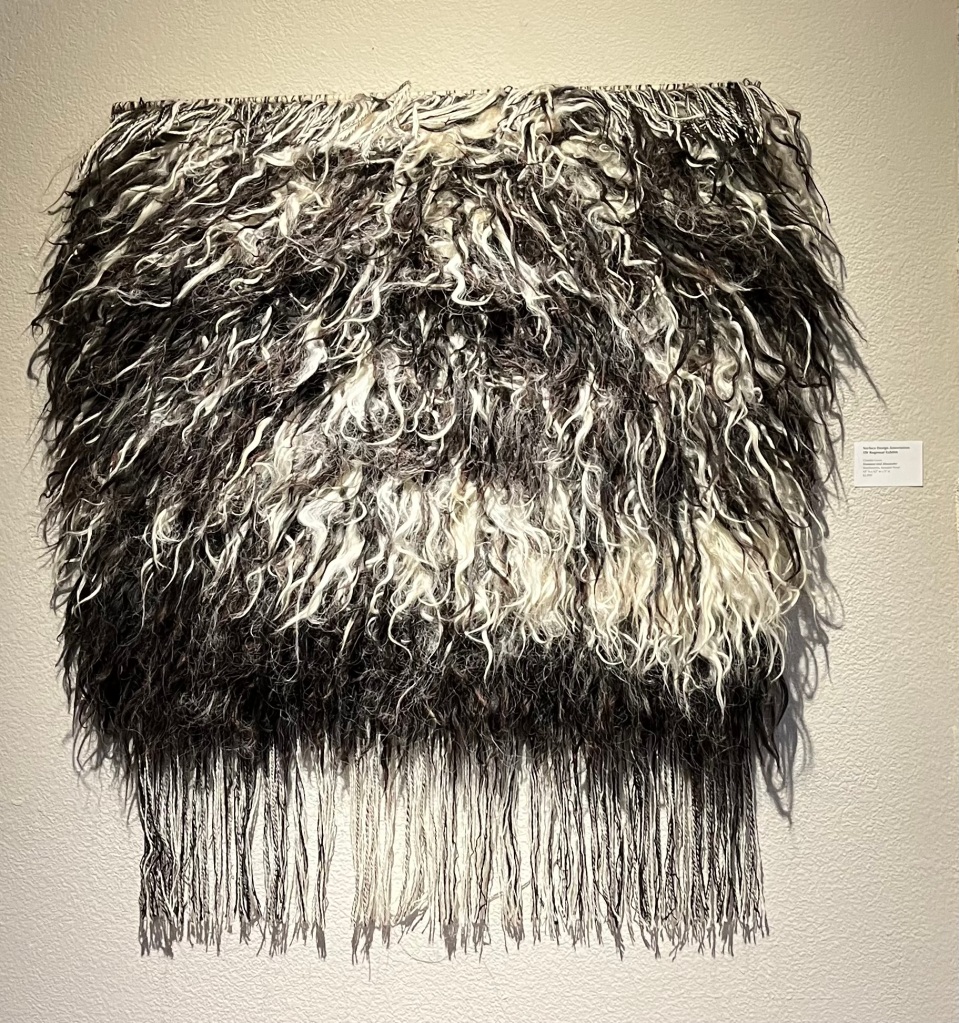This is a project that is definitely in the category of falling into the rabbit hole. It all started in 2020 when I clicked on a link from the Norwegian Newsletter by Robbie LeFleur. It featured a blog by Meg Rodgers, a crofter located in the Hebrides, who spent a two year journey researching the Norwegian migration to Scotland and ultimately Iceland. Meg’s blog about her experience is what inspired me to try weaving something similar at a local level. This included creating a Vararfeldur in the traditional manner – an Icelandic cloak in high demand by the Vikings in the 1100’s, made from the tips of short-tailed, double coated sheep. Long story short, I was only able to make the piece about one third the historically accurate size (about 2 yards by 4 yards). So I made it into a wall hanging which measures 35″ wide and 45″ long. But at least I can look at my creation and be content in how much I learned and grew from the experience.
Alexander and Roxanne are a Karakul sheep couple located in Tuscon, Arizona. In January of 2020 I was able to procure a half fleece from each of them from Sonja at The Farm at the End of the Road in Queen Creek. I could have had all of both fleeces, and in hindsight that would have allowed me to make a full size cloak. But I was so overwhelmed by the size of them, and took what I thought I could handle. Karakul are double coated, long tip sheep that originated in Namibia, Africa. They are well adapted to the heat and prosper in Arizona. Sonja raises them as part of the Shave’em to Save’em program sponsored by the Livestock Conservancy.


The Warp-Weighted Loom by Steins, Klingja and Steiner, provided a lot of history and guidance. Truth be told, a lot of this I ended up doing by the seat of my pants. I live in typical house in an urban setting, in a desert climate, not totally suited to the entire process of fiber production. What I found was that I eventually followed the seasons to be able to work both indoors and outdoors, to produce this woolen cloak.
The steps were numerous, with many missteps and corrections along the way. I adjusted my pace to cooperate with the weather. At first I thought I could wash the fleece in sections. Felting was an unhappy result. I needed to separate the top coat from the undercoat, and wash the locks and undercoat separately, and in small batches. The spring desert sun made a quick drying process. Although I had the vision of carding the undercoat and spinning it as the foundation material, I quickly found that wasn’t going to work. So I bought Karakul roving and spun about 1,300 yards of white/cream and black/grey, half of it plied cream and black. Building a warp weighted loom and weaving the cloak in the traditional manner wasn’t going to work for me. To handle the slightly sticky warp, I beamed a 2,2 twill on my 8 shaft Kessenich jack loom – over the eight shafts it wove beautifully and I only ran into a problem with the sides slacking as the very thick pile began to build up on the cloth beam. Sticks would have probably solved that situation, but I had run out of locks at that point so it was moot.
You wouldn’t imagine that such a thick pile (the locks ranged from 10 – 12 inches) could produce such a wonderful drape, but it did. It certainly wasn’t quick weaving. Prepping the locks was a process in and of itself. The sheared end of each lock (which still had a smidgeon of undercoat) was felted together so that when it was placed in the warp using the Icelandic Knot, the original length of the lock was mostly preserved. On April 24. 2022 I beamed the warp. on May 3, 2022 I cut the cloak off the loom.
Ultimately I used a double dowel system to mount the cloak, and after spending a brief time in exhibition at the Tubac Center of the Arts in Tubac, Arizona as part of the Surface Design Association”s Member juried exhibit, it is now hanging in my living room.



This was a tremendous experience. It opened my eyes to the seasonality of the entire fiber process, especially when trying to work and source as locally as possible. Sheep are sheared in the Spring, which is when you will find the freshest fleeces. Then comes the washing and the prepping of the fleece. After that is the spinning of the fiber, followed by the weaving of the cloth. So much pressure is applied by society to be constantly producing – consumption is king. But I learned that in following the path of nature and staying within the locality, a peaceful balance of existence can be maintained. There is no pressure to constantly produce, but to make what is fitting for the “now”. No overconsumption for the sake of appearing busy or productive. Making what you need, for when you need it, with what you have. And the rest of your time is spent living.

Wonderful blog post. And the results are beautiful!
Thank you so much!
Aloha Claudia 💚✨
Trusting you, Denny, and your loved ones are all well!
<
div>Th
Yes, indeed – and the same for you and yours!
Gorgeous. And I love your thoughts on the seasonality of the fiber process. It is something I have become very attuned to, especially with growing and processing flax.
I’m learning to spin flax now – hoping to weave hand spun linen at some point.